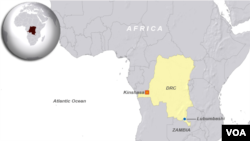Malaria is an entirely preventable and treatable mosquito-borne illness. At least that's what the World Health Organization claims. WHO statistics show the disease threatens up to 50 percent of the earth's population, and it kills more than a half-million people every year, most of them young children, but despite these grim statistics, progress is being made and lives are being saved.
Public and private funding for the past 10 years has cut deaths from malaria by nearly 50 percent worldwide. In sub-Saharan Africa, malaria deaths have been cut by 54 percent. That means more than 4 million lives have been been saved, most of them African children under the age of five.
Massive funds first started flowing into a program called The President's Malaria Initiative under President George W. Bush in 2005. The goal was to reduce deaths by 50 percent in 15 countries in sub-Saharan Africa.
The plan called for increasing medical treatment and scaling up prevention programs. It included providing 40 million bed nets treated with insecticide to reduce mosquito bites, spraying 5 million homes with insecticide, providing preventive treatment for 40 million pregnant women, training 16 million health workers, and distributing nearly 50 million rapid diagnostic tests and the same number of treatments using artemisinin-based therapies. Artemisinin is the most effective medication available for treating malaria.
New goal
President Obama has now funded the program for another six years. The new goal is to cut the number of malaria deaths by another third and to eradicate the disease entirely by 2050.
Other countries and organizations also have scaled up funding for anti-malaria programs. Since 2000, the level of funding for malaria has increased tenfold from $200 million to $2 billion.
Still, the U.S. is the world’s largest donor in the war against malaria. It's made a difference, according to Dr. Fatoumata Nafo-Traore. She heads the Roll Back Malaria Partnership, which coordinates the international anti-malaria effort from the World Health Organization headquarters in Geneva.
During a visit to VOA, Nafo, as she is called, said the impact of U.S. funding, beyond making medicine and bed nets available, is the investment in human capital - strengthening countries' health systems and training local health workers.
As a result, she said, "In any single village, you can use the [rapid] test and find out the results in 10 to 15 minutes." But even the vast amount of money earmarked for malaria control isn't enough. Nafo says anti-malarial programs are still short of 50 percent of the resources needed to fight malaria globally.
Challenges
The shortage increases the challenge of eradicating malaria. In Asia, the parasite that causes malaria is developing resistance to artemisinin. In Africa, mosquitoes are developing resistance to the most commonly used insecticides. Other insecticides can be used to kill mosquitoes, but at a higher cost.
Both developments are serious threats, said Dr. William Moss of the Johns Hopkins Malaria Research Institute, who spoke to VOA from Lubumbashi, in the Democratic Republic of Congo near the border with Zambia.
Artemisinin is normally used in combination with other medicines to treat malaria patients. Moss explained that artemisinin resistance is not like drug-resistant tuberculosis, in which drug therapy is ineffective. Instead, he said, it "is a delayed parasite clearance, so the parasites eventually clear [the blood stream] but they may require a longer duration of therapy."
It's a concern because "presumably, [it] is a first step to developing more complete resistance where the parasite doesn’t respond at all," Moss said.
Artemisinin resistance
The World Health Organization reports artemisinin resistance developing in Southeast Asia in areas with a high number of migrants. WHO is implementing an emergency response plan to scale up containment efforts there. Experts say they are particularly concerned about drug resistance developing along the border between Myanmar and India.
Moss said if resistance to artemisinin develops in India, it's only a matter of time before it develops in sub-Saharan Africa.
"There is a lot of movement that people, and presumably parasites [make] from India to sub-Saharan Africa," he said, "Those are well-traveled routes."
Moss said evidence is increasing that malaria control needs to be a regional effort. For example, the Democratic Republic of Congo borders nine other countries.
"And if it's not done together," he said, "the success and gains in a particular country can be undermined by the importation of malaria from their neighbors."
As for the new goals of The President's Malaria Initiative, Moss says he thinks they are achievable with the current tools available to fight the disease. But, he said those tools are going to be increasingly challenged by both insecticide resistance and drug resistance.







